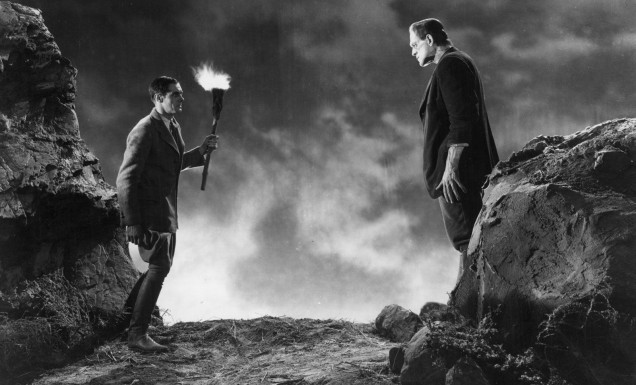Frankenstein
horror, USA, 1931
DIRECTED BY: James Whale

CAST:
Colin Clive (Henry Frankenstein),
Mae Clarke (Elizabeth),
John Boles (Victor Moritz),
Boris Karloff (The Monster),
Edward Van Sloan (Doctor Waldman),
Frederick Kerr (Baron Frankenstein),
Dwight Frye (Fritz),
Lionel Belmore (The Burgomaster),
Marilyn Harris (Little Maria)
SCRIPT:
John L. Balderston
PHOTOGRAPHY:
Arthur Edeson,
Paul Ivano
MUSIC:
Bernhard Kaun
EDITING:
Clarence Kolster,
Maurice Pivar
COSTUMES:
Mae Bruce
Synopsis:
Ever since his student days, the young scientist Henry Frankenstein has been obsessed with the idea of artificially creating human life. It seems that he could finally achieve this goal in a Bavarian castle, with the crucial help of his loyal assistant, the physically handicapped hunchback Fritz.
The two, namely, finally manage to assemble a human body from the parts of deceased people that they collected in secret from various sources. What Frankenstein definitely wants to succeed in is to use various electrical devices and devices to bring that body to life.
But because of Frankenstein's actions and plans, his fiancee Elizabeth, who is troubled by many things, is increasingly worried. She does not understand why Henry is hiding in an abandoned tower that he has equipped like a laboratory and where no one is allowed to visit him and Fritz. Therefore, Elizabeth, accompanied by her friend Victor Moritz, decides to visit Dr. Waldman, Henry's old medical professor, and ask for his help.
Persisting in their desire to save Frankenstein, they, led by Elizabeth, will break into his premises just as he is performing the final tests. But then a sudden lightning strike will occur, causing Frankenstein's devices to malfunction and break, causing his monster's arm to begin to move. Everything will be further complicated by the fact that Fritz acquired the brain of a criminal for Henry's experiments, which is why the revived creature will only be able to hate and kill.
The fantastic horror drama by director James Whale, a master of visually impressive stylized horrors often imbued with dark humor, irony and grotesque, is chronologically the third and to date the most famous screen adaptation of the story of Frankenstein, the classic Gothic novel by the English writer Mary Wollstonecraft Shelley.
The novel Frankenstein or the modern Prometheus, published in 1818, was previously adapted once as a feature film, in 1915 under the title Life Without Soul directed by Joseph W. Smiley, and twice in the form of a short film, in 1910 under the title Frankenstein and directed by J. Searle Dwaley and in 1921 in an Italian production directed by Eugenio Testa and entitled Il mostro di Frankenstein. But it was Whale's work that gained the status of a cult classic not only among horror fans, and the film enjoys such a reputation even today.
Although it is rather casually and superficially based on a literary template, while to a much greater extent its origin is in the dramatic text Frankenstein: An Adventure in the Macabre by the British playwright, novelist and poet Peggy Webling, which was written according to the original novel and which premiered in in December 1927, Whale's film is still today the most successful adaptation of the Frankenstein story.
Here too, the director brilliantly continues the tradition of German expressionism, which he skilfully transposed into an American film, which will be particularly evident on a stylistic level in his next genre-related works The Old Dark House and The Invisible Man ), based on the novel by H.G. Wells.
Expressionist stylizations are truly impressive, Whale in collaboration with screenwriter John L. Balderston (The Prisoner of Zende Castle by John Cromwell and W.S. Van Dyke, Gaslight by George Cukor) creates a horror atmosphere with less direct depictions and more with reliance on suggestion and psychosis, and the emphasis is deliberate and effectively placed on the characters' characters and their eccentricities.
The depiction of the monster as a kind of outsider who wants to fit into the human community is particularly intriguing, and this motif will be further highlighted in the sequel to the story of Frankenstein, also an extremely successful Bride of Frankenstein from 1935, again directed by James Whale.
The work from which the character of Frankenstein, for which Jack P. Pierce's brilliant mask is most deserving, became a recognizable symbol of the entire horror cycle of the Universal studio and its movie monsters, set new standards of the genre and made Boris Karloff famous in the character of Frankenstein, who turned into a leading actor of the horror film genre during the 30s.
The scientist Henry Frankenstein was originally supposed to be played by Bela Lugosi, but Universal executives were dissatisfied with the fact that the Hungarian actor spoke little English, so they offered him the role of a non-speaking monster. However, there was first dissatisfaction with the make-up that Lugosi insisted his character wear, and the vain actor soon decided to turn down a non-speaking role.
It was Whale who suggested the studio to Karloff, who sat in the director's chair instead of Robert Florey, who gave up the engagement, and who the actor attracted with his performances on the theater stages of Los Angeles.
These are not all replacements, because Henry Frankenstein was originally supposed to be played by Leslie Howard, who was eventually replaced by Colin Clive, while the role of Elizabeth was originally intended for Bette Davis. But when producer Carl Leammle Jr. decided that a performance in a horror film might harm Bette Davis' future star status, she withdrew, and Mae Clarke stepped in to replace her.
Text author: Josip Grozdanić
35 mm, b/w, 70'